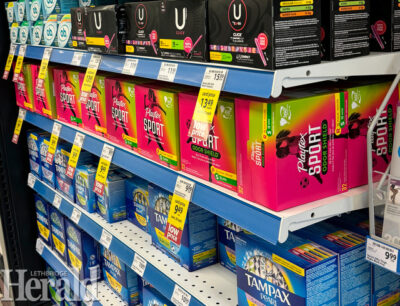Toxins finding their way into tampons: study
By Alexandra Noad - Lethbridge Herald Local Journalism Initiative Reporter on August 28, 2024.
 -
-On average a woman will use between 11,000 and 16,000 tampons in her lifetime, but what if these necessary products contain harmful toxins which could be causing adverse effects to a woman’s health?
A recent study from University of California Berkley of 30 tampons from 14 different tampon brands and 18 product lines found measurable concentrations of 16 metals including lead and arsenic.
The study was done on both organic and non-organic tampons. The non-organic tampons contained higher traces of lead and the organic tampons contained higher traces of arsenic.
Josee Bosgra, a Natural Nutrition Clinical Practitioner in Lethbridge who obtained her diploma from Alive Academy in B.C., says while it’s alarming to hear these statistics it isn’t surprising.
“Any sort of toxin exposure should be a concern. I think it’s a bigger conversation, though. I don’t think this is news…the idea of the things that are coming into really intimate contact with our bodies being toxic is not new. And no, it’s not surprising because we live in such a toxic world,” said Bosgra.
According to the study there are many ways these metals are finding their way into the tampon. Many tampons are made out of cotton, which is a very absorbent plant.
One theory suggests the metals are being soaked up by the plant from the soil or are being contaminated from nearby areas from the winds.
Another theory is they are intentionally being added during manufacturing as part of pigment, whitener, antibacterial agent, or some other process in the factory producing the products.
An article on The National Library of Medicine website, written by Mahdi Balaali-Mood, Kobra Naseri, Zoya Tahergobi, Mohammad Reza Khazdair and Mahmood Sadeghi published on April 13, 2021 says mercury, lead, chromium, cadmium and arsenic have been the most common heavy metals to induce human poisonings. it went on to say heavy metals disrupt cellular events including growth, proliferation, differentiation, damage-repairing processes and apoptosis.
Brosgra explained human bodies only have a certain threshold for toxins, which most people are exceeding.
“We all have this threshold at which we can deal with toxicity and most people walking around today far surpassed that threshold and don’t realize that many of these ailments that are that they’re experiencing are actually related to toxicity. It’s related to an inability to drain and detox toxins like heavy metals because their systems have been overloaded far past what it was designed to deal with,” said Bosgra.
While it is unclear whether or not the heavy metals can leach out of the tampon, Bosgra suggests women who are concerned by these findings use a silicone menstrual cup or make their own reusable pads.
“When it comes to these menstrual products, definitely opting for like if you can opt for a cup that’s medical grade silicone or even like make your own organic cotton cloth pads. It doesn’t mean that there’s going to be no toxins in the fabric that you’re using, but you can kind of control what materials you are using and you know how to sew, then that’s pretty easy to do,” said Bosgra.
Bosgra mentioned reusable options may not be accessible to everyone and there are other ways of helping the body to eliminate toxins such as supporting your lymphatic system by walking, jumping and exercising in general and your liver by eating pesticide free fruits and vegetables and drinking purified water.
While this is the first study done on heavy metals in tampons, California University Berkley suggests future research will be done to test how much of the levels of the metals can leach out and be absorbed by the body as well as measuring the presence of other chemicals in tampons.
16-15


